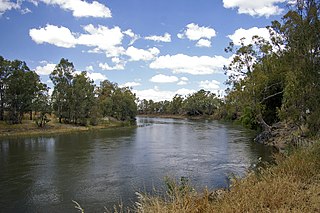Country
Nari-Nari country consists of some 14,000 square kilometres (5,500 sq mi) of land. The western border lay on the southern bank of the Lachlan River, from Booligal, to just above Balranald. From here, running eastwards it followed the line of the Murrumbidgee River to Hay; south to about Booroorban. The Wemba-Wemba tribal frontier formed its southern border, while the Baraparapa lay on its southeastern flank. To their northwest were the Jitajita.
Today the Nari-Nari people are represented by the Nari-Nari Tribal Council, formed in 2000. The council has, through the Indigenous Land Corporation, purchased two stations west of Hay to ensure the continued protection of the sites.

The Murrumbidgee River is a major tributary of the Murray River within the Murray–Darling basin and the second longest river in Australia. It flows through the Australian state of New South Wales and the Australian Capital Territory, descending 1,500 metres (4,900 ft) over 1,485 kilometres (923 mi), generally in a west-northwesterly direction from the foot of Peppercorn Hill in the Fiery Range of the Snowy Mountains towards its confluence with the Murray River near Boundary Bend.

The Yorta Yorta, also known as Jotijota, are an Aboriginal Australian people who have traditionally inhabited the area surrounding the junction of the Goulburn and Murray Rivers in present-day north-eastern Victoria and southern New South Wales.

Oxley is a community on the lower Lachlan River in the Riverina district of New South Wales, Australia near the junction of the Lachlan and Murrumbidgee Rivers. The township which developed in the mid-1860s was named after the noted Australian explorer, John Oxley. At the 2006 census, Oxley had a population of 159 people.

The Wemba-Wemba are an Aboriginal Australian group in north-Western Victoria and south-western New South Wales, Australia, including in the Mallee and the Riverina regions. They are also known as the Wamba-Wamba.

The Barapa Barapa people are an indigenous Australian people whose territory covered parts of southern New South Wales and northern Victoria. They had close connections with the Wemba-Wemba.
The Wemba Wemba language is an extinct Aboriginal Australian language once spoken along the tributaries of the Murrumbidgee River.

The Wilyakali or Wiljaali are an Australian aboriginal tribal group of the Darling River basin in Far West New South Wales, Australia. Their traditional lands centred on the towns of Broken Hill and Silverton and surrounding country. Today the Wilyakali people of Broken Hill are still the main Aboriginal group living in Broken Hill.

The Paakantyi, or Barkindji or Barkandji, are an Australian Aboriginal tribal group of the Darling River basin in Far West New South Wales, Australia.

The Ngarigo are an Aboriginal Australian people of southeast New South Wales, whose traditional lands also extend around the present border with Victoria.

The Muthi Muthi people are an indigenous Australian people whose traditional lands are located in the Northern Riverina and Far West regions of New South Wales.

The Kureinji, otherwise known as the Keramin, are an Aboriginal group whose traditional lands are located in southwest New South Wales, Australia, along the north side of the Murray River roughly between today's settlements of Euston and Wentworth.

The Dadi Dadi or Tatitati are an Australian Aboriginal tribe whose traditional lands are located along the southern banks of the Murray River in Victoria Australia.
The Maraura or Marrawarra people are an Aboriginal group whose traditional lands are located in Far West New South Wales and South Australia, Australia.
The Barindji, also written Parrintyi, are an indigenous Australian people of the state of New South Wales. They are to be distinguished from the Paaruntyi, who spoke a similar language but whom they called the spitting people.
The Watiwati are an indigenous Australian aboriginal people traditionally living on both sides of the Murray River, from Victoria to New South Wales.
The Jitajita, otherwise spelt Yitayita, are an indigenous Australian people of southern New South Wales.
The Latjilatji, sometimes spelt Latji Latji or Latje Latje are an Indigenous Australian people of the state of Victoria, Australia.
The Malyangaapa are an Indigenous Australian Tribe of people who live in the far western areas of the state of New South Wales.
The Naualko (Nhaawuparlku) were an indigenous Australian people of New South Wales.
The Ildawongga are an indigenous Australian people of the Pilbara region of Western Australia.
This page is based on this
Wikipedia article Text is available under the
CC BY-SA 4.0 license; additional terms may apply.
Images, videos and audio are available under their respective licenses.









